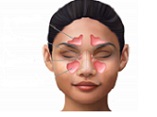Epidemiology of Anatomical Variations in the Maxillary Sinus Drainage System and the Impact of Concha Bullosa
DOI:
https://doi.org/10.31661/gmj.v13iSP1.3585Keywords:
Cone-beam Computed Tomography; Paranasal Sinuses; Maxillary SinusAbstract
Background: The ostiomeatal complex (OMC) is an important anatomical structure which contains the maxillary ostium and infundibulum; sinus drainage is performed through this route. Concha bullosa, which is defined as pneumatization of the middle concha, may lead to drainage disorders and sinusitis following alterations in the OMC; hence, the purpose of this study was to investigate the effect of presence of concha bullosa on the infundibulum length and ostium height using cone-beam computed tomography (CBCT). Materials and Methods: This cross-sectional study evaluated 208 CBCT scans of 416 maxillary sinuses, which were retrospectively selected from the records available in the CBCT archives. Measurement of infundibulum length and maxillary ostium height were compared based on the presence of concha bullosa. Results: Out of 416 sinuses, 184 (44.2%) had concha bullosa. There was no significant relationship between concha bullosa and age or gender (P>0.05). However, significant differences were observed in infundibulum length and ostium height between genders, with males having longer infundibulum lengths (right: 15.59 mm, left: 15.54 mm, total: 15.56 mm, P<0.001) and higher ostium heights (right: 31.68 mm, left: 32.30 mm, total: 31.99 mm, P=0.001). Concha bullosa presence significantly affected infundibulum length and ostium height on the right side, with shorter lengths (11.83 mm vs. 13.47 mm, P=0.004) and higher heights (30.69 mm vs. 28.51 mm, P=0.001) in those with concha bullosa. No significant correlations were found between age and infundibulum length or ostium height (P>0.1). Gender-specific differences were noted, with females showing significant impacts on the right side and males on both sides. Conclusion: In the present study, presence of concha bullosa shortened the infundibulum length and increased the ostium height. Also, the infundibulum length and ostium height were greater in males than females.
References
Sala YM, Lu H, Chrcanovic BRJJoCM. Clinical Outcomes of Maxillary Sinus Floor Perforation by Dental Implants and Sinus Membrane Perforation during Sinus Augmentation: A Systematic Review and Meta-Analysis. journal of Clinical Medicine. 2024;13(5):1253.
https://doi.org/10.3390/jcm13051253
PMid:38592698 PMCid:PMC10932102
Deng Y, Ma R, He Y, Yu S, Cao S, Gao K et al. Biomechanical analysis of the maxillary sinus floor membrane during internal sinus floor elevation with implants at different angles of the maxillary sinus angles. International Journal of Implant Dentistry. 2024;10(1):11.
https://doi.org/10.1186/s40729-024-00530-5
PMid:38472687 PMCid:PMC10933249
Akay G, Yaman D, Karadağ Ö, Güngör KJMP. Evaluation of the relationship of dimensions of maxillary sinus drainage system with anatomical variations and sinusopathy: cone-beam computed tomography findings. Medical Principles and Practice. 2020;29(4):354-63.
https://doi.org/10.1159/000504963
PMid:31760388 PMCid:PMC7445673
de Carvalho ABG, Costa ALF, Fuziy A, de Assis ACS, Veloso JRC, Junior LRCM et al. Investigation on the relationship of dimensions of the maxillary sinus drainage system with the presence of sinusopathies: a cone beam computed tomography study. Archives of Oral Biology. 2018;94:78-83.
https://doi.org/10.1016/j.archoralbio.2018.06.021
PMid:29990588
Serindere G, Bilgili E, Yesil C, Ozveren NJISiD. Evaluation of maxillary sinusitis from panoramic radiographs and cone-beam computed tomographic images using a convolutional neural network. Imaging Science in Dentistry. 2022;52(2):187.
https://doi.org/10.5624/isd.20210263
PMid:35799961 PMCid:PMC9226235
Gu YJAoOB. Commentary: Dimensions of the maxillary sinus drainage system associated with pathology of the sinus. Archives of Oral Biology. 2018;96:233.
https://doi.org/10.1016/j.archoralbio.2018.08.019
PMid:30213380
Tassoker M, Magat G, Lale B, Gulec M, Ozcan S, Orhan KJEAoO-R-L. Is the maxillary sinus volume affected by concha bullosa, nasal septal deviation, and impacted teeth? A CBCT study. 2020;277:227-33.
https://doi.org/10.1007/s00405-019-05651-x
PMid:31542830
Lee J, Park SM, Cha S-W, Moon JS, Kim MSJJotKSoR. Does Nasal Septal Deviation and Concha Bullosa Have Effect on Maxillary Sinus Volume and Maxillary Sinusitis: A Retrospective Study. Journal of the Korean Society of Radiology. 2020;81(6):1377.
https://doi.org/10.3348/jksr.2019.0169
PMid:36237721 PMCid:PMC9431850
Al-Rawi NH, Uthman AT, Abdulhameed E, Al Nuaimi AS, Seraj ZJIsid. Concha bullosa, nasal septal deviation, and their impacts on maxillary sinus volume among Emirati people: A cone-beam computed tomography study. Imaging science in dentistry. 2019;49(1):45.
https://doi.org/10.5624/isd.2019.49.1.45
PMid:30941287 PMCid:PMC6444003
Al-Sebeih KH, Bu-Abbas MHJE. Concha bullosa mucocele and mucopyocele: a series of 4 cases. Ear, Nose & Throat Journal. 2014;93(1):28-31.
https://doi.org/10.1177/014556131409300107
Demir UL, Akca M, Ozpar R, Albayrak C, Hakyemez BJS, Anatomy R. Anatomical correlation between existence of concha bullosa and maxillary sinus volume. Surgical and Radiologic Anatomy. 2015;37:1093-8.
https://doi.org/10.1007/s00276-015-1459-y
PMid:25772518
Shin J-M, Baek BJ, Byun JY, Jun YJ, Lee JYJANL. Analysis of sinonasal anatomical variations associated with maxillary sinus fungal balls. Auris Nasus Larynx. 2016;43(5):524-8.
https://doi.org/10.1016/j.anl.2015.12.013
PMid:26811302
Azila A, Irfan M, Rohaizan Y, Shamim AJTMJoM. The prevalence of anatomical variations in osteomeatal unit in patients with chronic rhinosinusitis. The Medical Journal of Malaysia. 2011;66(3):191-4.
Vaddi A, Villagran S, Muttanahally KS, Tadinada AJISiD. Evaluation of available height, location, and patency of the ostium for sinus augmentation from an implant treatment planning perspective. Imaging Science in Dentistry. 2021;51(3):243.
https://doi.org/10.5624/isd.20200218
PMid:34621651 PMCid:PMC8479432
Basurrah MA, Kim SWJSMJ. Factors affecting dimensions of the ethmoid infundibulum and maxillary sinus natural ostium in a normal population. Saudi Medical Journal. 2021;42(9):981.
https://doi.org/10.15537/smj.2021.42.9.20210399
PMid:34470836 PMCid:PMC9280512
Shetty N, Gavand K, Bhutani H, Rode S, Pol B, Waghmare MJJoIAoOM. Evaluation of the Relationship of Dimensions of Maxillary Sinus Drainage System (Osteomeatal Unit) with Anatomical Variations and Sinusopathy: A Pilot Study. Journal of Indian Academy of Oral Medicine and Radiology. 2024;36(1):35-40.
https://doi.org/10.4103/jiaomr.jiaomr_262_23
Tomblinson C, Cheng M-R, Lal D, Hoxworth JJAJoN. The impact of middle turbinate concha bullosa on the severity of inferior turbinate hypertrophy in patients with a deviated nasal septum. 2American Journal of Neuroradiology. 016;37(7):1324-30.
https://doi.org/10.3174/ajnr.A4705
PMid:26939632 PMCid:PMC7960348
Koo SK, Kim JD, Moon JS, Jung SH, Lee SHJANL. The incidence of concha bullosa, unusual anatomic variation and its relationship to nasal septal deviation: a retrospective radiologic study. Auris Nasus Larynx. 2017;44(5):561-70.
https://doi.org/10.1016/j.anl.2017.01.003
PMid:28173975

Published
How to Cite
Issue
Section
License
Copyright (c) 2024 Galen Medical Journal

This work is licensed under a Creative Commons Attribution 4.0 International License.







